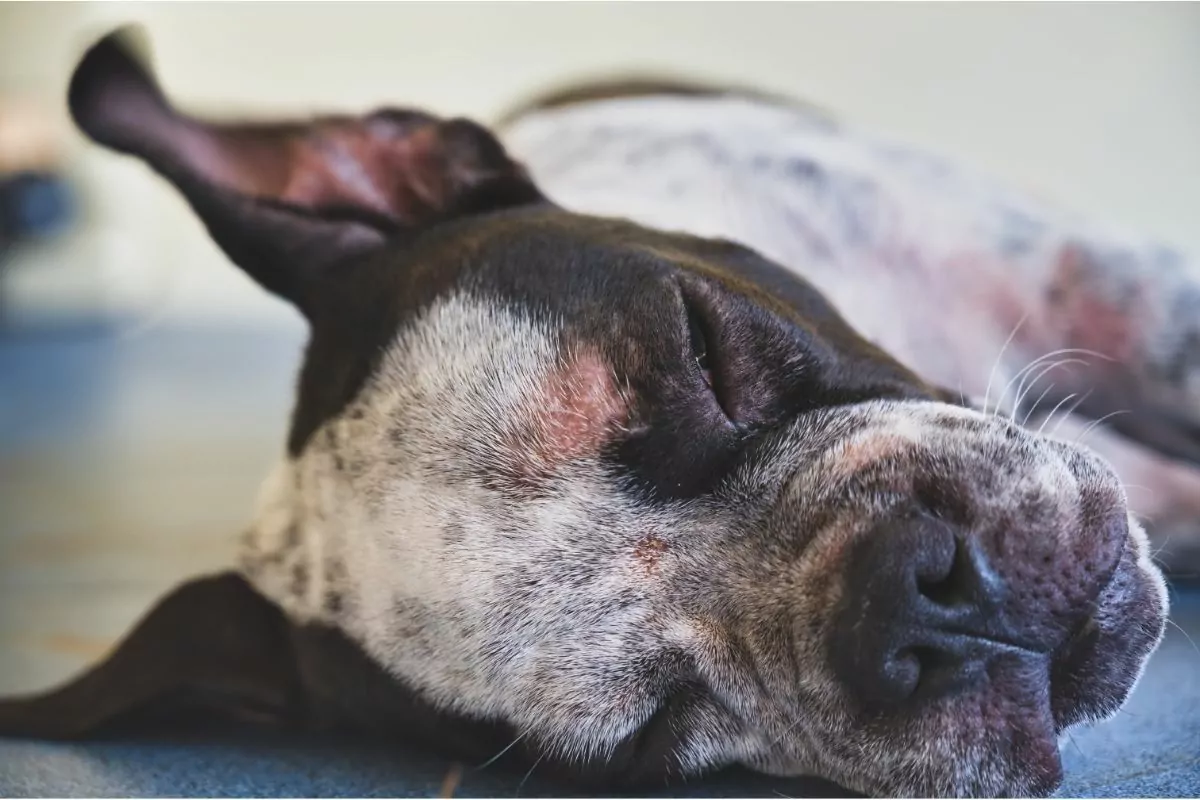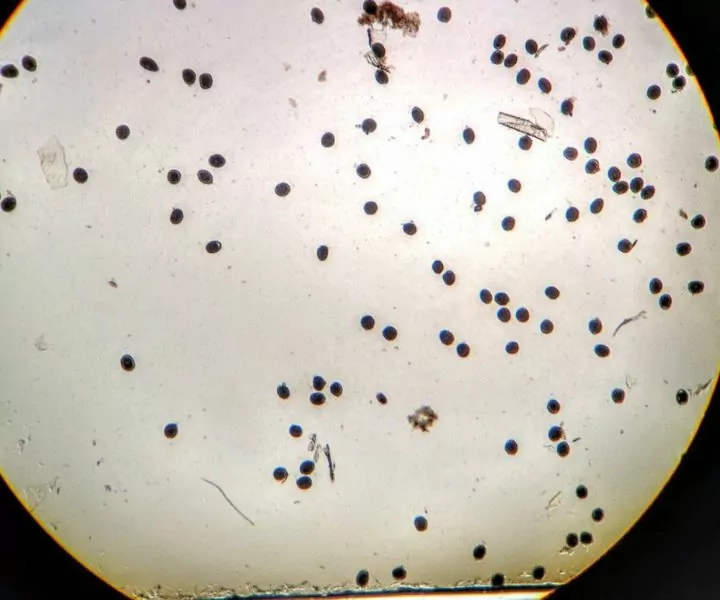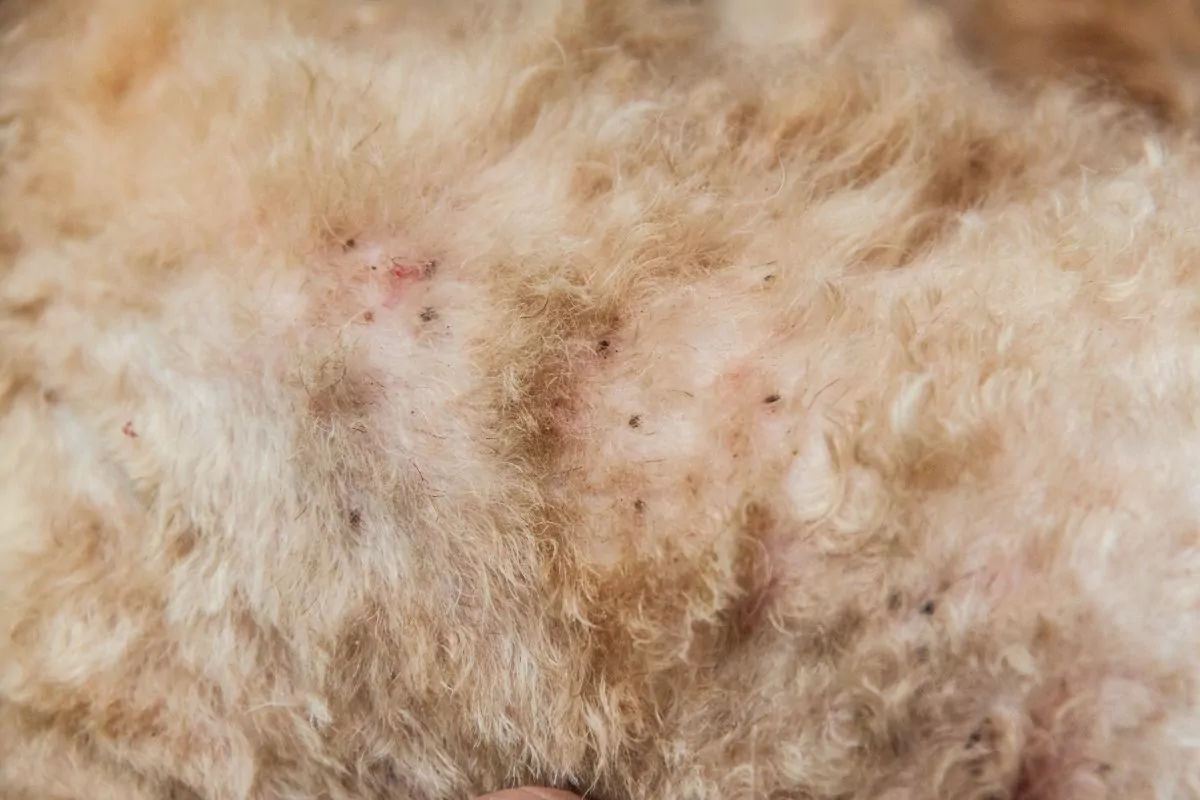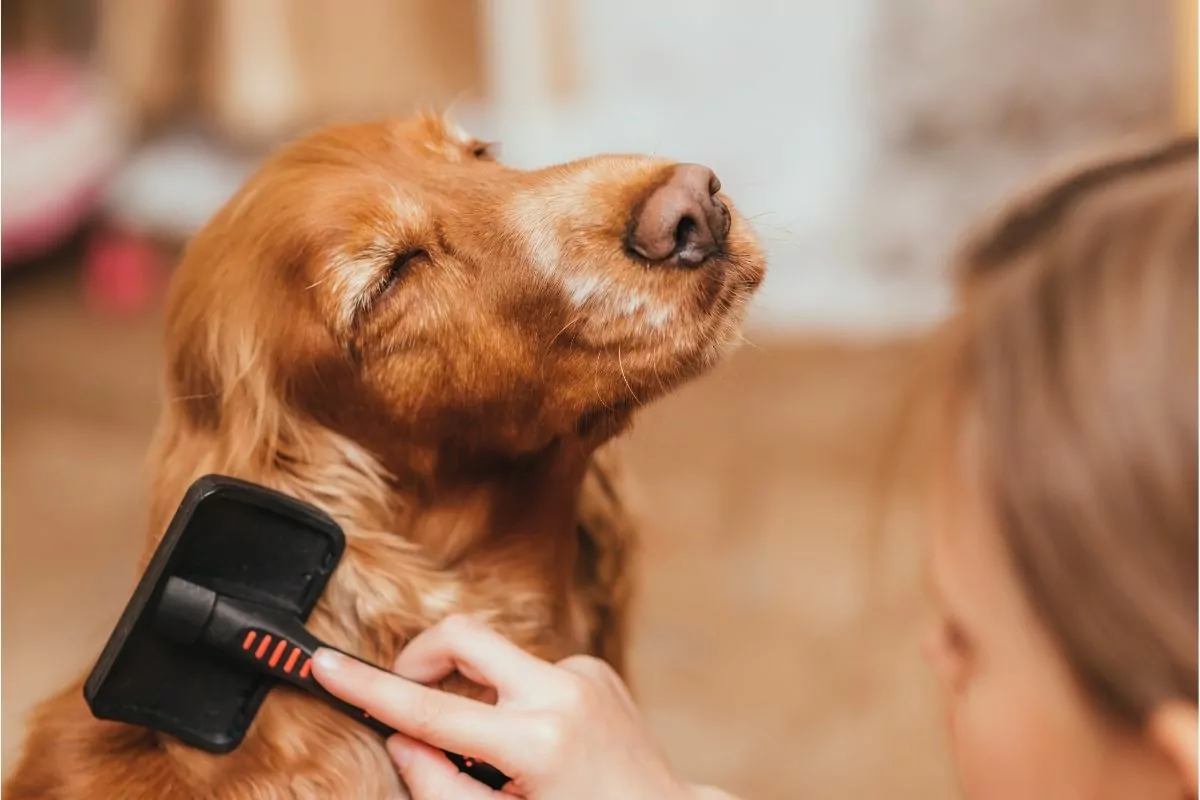My Dog Has Skin Problems – What Now?
If you are struggling with dog skin problems, pictures can help determine what you might need to do to start getting your pet back to its happy and healthy self. Dog skin problems can leave pet owners feeling frustrated and often itching for answers about what is causing their pet’s discomfort.
The 10 Most Common Dog Skin Problems
1. Allergic Dermatitis
A significant number of animals have overactive immune systems or hypersensitivity disorders that can manifest as skin conditions.
A dog’s allergies can be incredibly frustrating to treat and even more frustrating to live with, so owners often want a quick fix to help alleviate symptoms and stop scratching. However, patience and compliance are vital in treating allergies. Identifying the allergen is very important and requires extensive testing and a strict treatment plan to rule out issues to get a diagnosis.
Treating allergies can be done in the following ways:
- Avoiding allergen contact or consumption
- Exclusion trials or prescription diets
- Immunomodulatory drugs like Apoquel or Atopica
- Corticosteroid therapy

2. Fungal Infection
Introduction of fungi from chronic scratching or injury occasionally happens when the skin barrier is compromised. Two common fungal infections seen are:
Ringworm is a fungal infection that causes circular hair loss or inflammation patches and can occur in any body area. The lesions often also have scaly patches, redness, and hair loss – it’s pretty common in puppies and can be transmitted to owners or other dogs as well.
Ringworm treatment can include optical antifungal creams or oral medication if the infection is significant.

- Yeast Infection
Mallasezzia occurs more frequently in the summer months and can cause significant hot spots in a short period of time due to the itchy nature of the pathogen. Yeast infections occur mainly at the base of the ears and around the neck, in between skin folds or between the paws. Owners can usually smell a yeast infection before they notice clinical symptoms.
Treatment includes avoiding sugary treats or high-carb meals and adding a probiotic to your pet’s meal to help alleviate the symptoms of a yeast infection. In addition, medicated shampoos, as well as a topical ointment, may be necessary if your pet has a severe yeast infection.
3. Folliculitis
Folliculitis refers to inflammation of the tunnel-shaped structure in the outer dermal layer of the skin that anchors the hair in place. The inflamed hair follicle will have a “goosebump” like appearance but may also have a small pustule, crusty, or scaly surface around the affected area and caused by bacterial infections.
Treatment includes either topical creams, systemic antibiotics, or anti-inflammatory medication. Treating the primary condition is critical when dealing with secondary bacterial infections, or else they will simply recur.
4. Impetigo
Impetigo is a bacterial infection commonly seen in puppies who develop small pus-filled blisters, mostly on their abdomens or hairless areas of skin.
It is not considered a severe condition and either resolves by itself, or it can be treated with a topical medicated shampoo or ointment. However, if it spreads, it is best to consult with a veterinarian and possibly start on a short course of antibiotics.
5. Seborrhoea
The term seborrhoea describes dandruff shedding or greasy skin coat related to either a genetic disorder or other skin conditions relating to hormonal abnormalities, autoimmune diseases, or parasites.
Genetic disorder-related seborrhoea occurs within the first two years of a dog’s life and will be a chronic condition that needs treatment.
Idiopathic seborrhoea cannot be cured; it can only be managed through good hygiene habits and adjusted nutrition. In cases of secondary dandruff and greasy skins, then medicated dog shampoos will help.
6. Alopecia
Alopecia describes hair loss or excessive shedding, which could have multiple etiologies. Some common causes include stress, poor nutrition, self-trauma, and depilation due to allergies, infection, or parasitic infestations.
Rare genetic causes of alopecia also exist. Secondary alopecia is due to hormonal imbalances or immune-mediated disease. Treatment depends on the cause and may include balanced diets which contain hair stimulating nutrients like Vitamin D, melatonin, and oils rich in omega – 3 fatty acids.

7. External parasites
External parasites have evolved to be small and well camouflaged within their host’s coats, so often, owners will not see that their pet has an external parasite problem. The three main parasites that cause dog skin problems are:
- Mites
Mites cause a condition known as mange, and commonly seen areas of hair loss and itching around the eyes, muzzle, and ears are notable when dealing with mange. Diffuse mange can cause severe thickening of the skin and complete hair loss.
Treatment options can include topical products with macrocyclic lactones like selamectin, oral milbemycin, or injectable ivermectin.
Fleas cause a notable itching in the area known as the lumbosacral area, which is the area between the lower back and the tail. Many owners don’t see fleas, but fleas are the most common cause of dog skin problems, so most vets will always start with flea treatment as a first step.
Treatment options for flea infestation must be done both to the patient and the environment to ensure the flea’s lifecycle is broken. Flea treatments are readily available online and in stores, but flea larvae-killing products containing pyriproxyfen or methoprene specifically are also strongly advised.
Ticks can attach anywhere to your pet regardless of coat type or length. They elicit painful bites and irritate the surrounding skin, which often leads to dogs self traumatizing the tick attachment site. Ticks also transmit several diseases in their saliva, so avoiding tick bites is of the utmost importance.
Treatment options require that a tick is physically removed using tweezers to gently pull the entire tick off your pet without breaking the head off in the skin, which can lead to an infection. An insecticidal dip will also help heavily infested pets as the tick will fall off as they die.

8. Cancer
Skin cancers are uncommon, but they are severe as they require immediate attention. Any lumps, areas of discoloration, or ulcerated lesions need to be seen by a vet as soon as possible.
Treatment will depend on the type of cancer identified, but most often, excisional biopsies to identify and stage the growth or radiation or chemotherapy will be needed.
9. Immune disorders
Immune system disorders like pemphigus foliaceus or discoid lupus are infrequent conditions caused by the immune system overreacting and severe inflammation, crusting, and painful lesions. The lesions are often found in the mucocutaneous areas like the nose bridge, muzzle, or eyes.
Treatment will depend on the type of disorder, but often immunosuppressive therapy or drugs are required.
10. Systemic diseases
Systemic diseases like Cushing’s syndrome or hypothyroidism can affect skin health and compromise the skin barrier. Vital signs like increased water intake, increased urination, heat-seeking behavior, chronic scratching, poor healing time or abdominal distention, and hair loss can be indicators of systemic disease.
Treatment will depend on the type of systemic disease diagnosed. For example, hypothyroidism is easy to manage with daily chronic medication, but conditions like Cushing’s may need a combination of chronic medicine and possibly surgery.
Signs and Symptoms Associated with Skin Problems in Canines
It is important to regularly groom your pets to monitor their coat for underlying skin conditions and detect changes early. Some early signs of dog skin problems may include:
- Loss of coat luster
- Increased shedding.
- White flakes (dry skin) on your pet’s coat
- Itching
- A sweet-sour smell.
- Oily texture or appearance of the coat.
- Swollen or raised patches of skin.
- Discoloration of the skin.
- Pustules, pimples of hair loss.
- Reddish swellings known as papules.
- Circular areas of crusty or scaly skin.
What Is The Difference Between Primary and Secondary Dog Skin Problems?
A primary dog skin problem is caused by a specific disease process. In contrast, a secondary dog skin problem is due to the consequences of the disease, such as itching or inflammation that then causes increased self-trauma and scratching that can introduce pathogens into the skin and cause problems.
Identifying the primary issue is critical as the secondary problem is simply a symptomatic manifestation of the underlying cause. If the primary conditions are left untreated, then the secondary conditions will just recur.
Skin conditions can be frustrating because of the numerous causes, so it is essential to follow your vet’s advice closely to rule out causes systematically.
Dog Skin Problem FAQs
1.Why is my dog itching after we have tried everything?
Treating itching skin is one of the most challenging cases as a veterinarian because often, several factors will lead to regression or a lack of progress. However, as an owner with a dog with skin problems, compliance is the most crucial step in treating your pet.
By adding or changing aspects of a pet’s treatment plan, you inadvertently compromise the diagnostic viability of your next vet visit. Always consult with your vet before changing or stopping any medication or treatments.
2. My dog does not have external parasites. So why must I treat them?
You may not see parasites on your pet – the treatment aims to prevent your pet from getting them in the first place because it could lead to a severe flare-up or, even worse, having to start from scratch. It also helps rule out the cause of skin problems which will help you get a diagnosis faster.
3. When can I stop the treatment?
Dogs who suffer from skin problems will have a chronic predisposition to issues in the future. Hence, it is in your and your pet’s best interest to keep up with preventative measures and closely monitor skin health to detect early problems and don’t progress to secondary issues.
4. What treats can I give my dog that has skin problems?
It is always best to try and stick with hypoallergenic options when dealing with dogs with skin sensitivities – the best option is even to take a portion of their daily ration from their particular canine diet and use those as treats throughout the day to fully avoid any flare-ups.
5. Why is my itchy dog costing me a fortune when I can easily just try cortisone instead?
One of the most limiting and frustrating aspects of owning a dog with skin problems is the cost involved in preventative treatments, vet visits, diagnostics tests, prescription foods, shampoos, and medication.
Unfortunately, due to the complicated nature of skin conditions, it’s not just as easy as giving a cheap cortisone tablet. Cortisone is a drug used sparingly as it has several adverse effects, especially if used chronically.
The key to getting your dog as healthy as possible is to rather focus on a long-term treatment plan instead of a short-term quick fix.
Your 9 Step Canine Skin Problem Prevention Plan
1.Dry, flaking skin
The dryness of a dog’s skin can cause itching and discomfort. Still, it is most likely a secondary symptom of an underlying condition or due to changing seasons or nutritional deficiencies.
Prevention
The cause of the dry skin would ideally need to identify to prevent the problem, but a few basic steps can include:
- Ensuring your pet has a balanced diet and possibly supplementing with skin support nutrients containing omega fatty acids, coconut, or fish oils.
- Grooming – do not overgroom your pets, and also be mindful of the shampoo you use to ensure it is the correct pH for your dog’s skin.
- Brushing your pet regularly helps with releasing natural oils from their skin onto their coat, giving them a healthy sheen.

2. Allergic Dermatitis
Allergies are one of the most frustrating conditions to treat in dogs due to the cost, time, and dedication required to find the underlying cause of the issue. In addition, contact allergies, environmental allergies, food allergies, or atopy can cause relentless scratching, self traumatization, and secondary infections if left untreated.
Prevention
Prevention of allergies is often the first step in the road to alleviating the symptoms, but it is imperative to dedicate the effort to determine the underlying cause.
Environmental allergies are difficult to prevent, but one can avoid taking pets out onto grass areas or avoiding high pollen times of the day. Remove trees or flowers that make the allergies worse or replace grass with astroturf.
Contact allergies also need to be avoided, so refrain from changing detergents or ensure that bedding is hypoallergenic or that pets are denied access to furniture that may cause rashes or itches.
Food allergies – try to avoid non-hypoallergenic snacks or foods that cause flare-ups. Atopy requires strict adherence to prescribed medication to help mediate the immune systems’ over-reactivity and prevent secondary conditions that can take ages to resolve.
3.External parasites
External parasite control is one of the most important elements in preventing dog skin problems. It is the easiest step on your pet’s road to recovery because it’s readily available online or in stores. It’s easy to administer with various options that suit your pet, and it works quickly.
Prevention
There are many products available to prevent all three parasites mentioned above, so consult with your pet store or veterinarian on which one suits your pet and budget the best. It is also advisable to avoid other dogs with flea, mite, or tick infestations to minimize the risk of your dog picking up an unwanted parasite.
4.Bacterial infections
The most common cause of secondary dog skin problems is bacteria. Commensal bacteria occur naturally on the skin’s surface and are generally benign as they form part of a dog’s natural skin barrier defense.
Bacteria becomes a problem when the skin barrier is compromised either through an injury or through other means by which non-commensal bacteria over-proliferate and cause an infection.
Commensal bacteria like Staphylococcus species are the most common organisms that cause bacterial infections when the skin barrier is compromised.
Prevention
Bacterial infections can be avoided with medicated shampoo washes and early intervention in pruritic dogs to avoid secondary infection and dermatitis.
5. Fungal infections
Fungal infections can be prevented through good hygiene and regular grooming, as well as avoiding contaminated dogs.
6. Seborrhoea
If the seborrhoea is genetic, there is no way to prevent it, but it can be managed. In contrast, secondary causes of seborrhoea can be controlled with reasonable primary animal health measures, avoiding allergens and medicated shampoos.
7.Alopecia
Hair loss is an easy symptom to pick up but challenging to prevent. In addition, there is strong evidence that nutrition is closely related to alopecia, so good quality dog food is vital in treating the condition.
Good external parasite and hygiene and stress-free environments are the best preventative measures to avoid alopecia and choose responsible breeders who avoid genetic alopecia lines.
8. Skin cancers
Skin cancers in dogs can be caused by viruses, hormones, or genetic factors. Still, statistically, patients with minimal pigment or dogs with a predisposition to cancer need to be closely monitored to prevent skin cancers from progressing to a point where it is more difficult to treat them effectively.
Prevention
Preventing cancer includes less sun exposure, enough shade in the summer months, and sunscreen application in dogs with light fur or lack of pigment.
9. Immune disorders
Immune disorders cannot be prevented per se. Still, they can be closely monitored, and complications can be prevented or detected early, so be sure to regularly visit your vet for checkups to ensure your pet stays happy and healthy.
When Should I Take My Dog To The Vet?
Most skin conditions take time to develop and are not necessarily emergencies. Still, the chronic itchy or painful lesions that develop can cause your pet significant discomfort in the long term. Therefore, as soon as you notice your pet has a slight abnormality, it is best to contact your vet for a consultation to rule out any issues which may flare up into costly secondary infections.
Excessive licking, scratching, or painful lesions can have a drastic effect on our pet’s welfare, so the sooner you can alleviate their problem, the better for both you and your dog.
If you notice any small growths or discolored lesions on your pet’s skin, it is best to get it seen as soon as possible, especially in dogs with minimal pigment.
The Tail End of Our Story
Don’t let skin conditions get under your skin or your pet’s skin either – prevention is key in most skin issues, so monitor your dog’s skin health with weekly grooming or inspection, and you will be able to spare yourself the time and the money of dealing with secondary skin problems.
